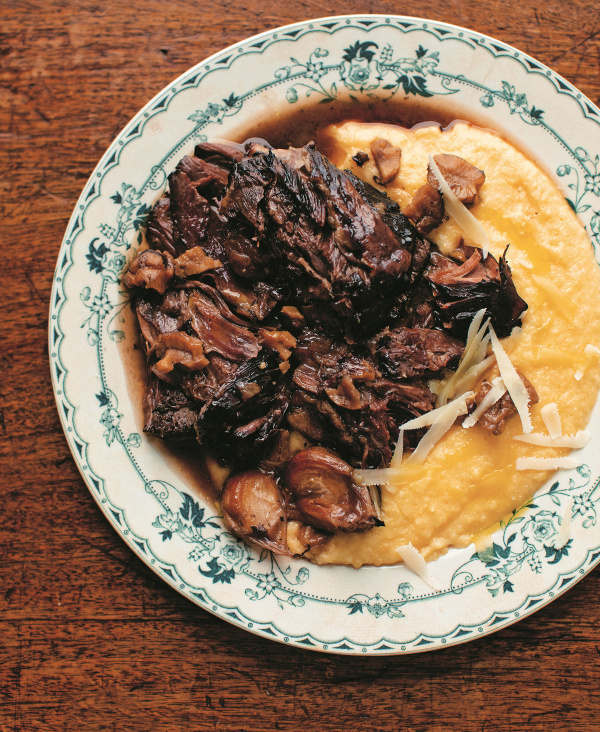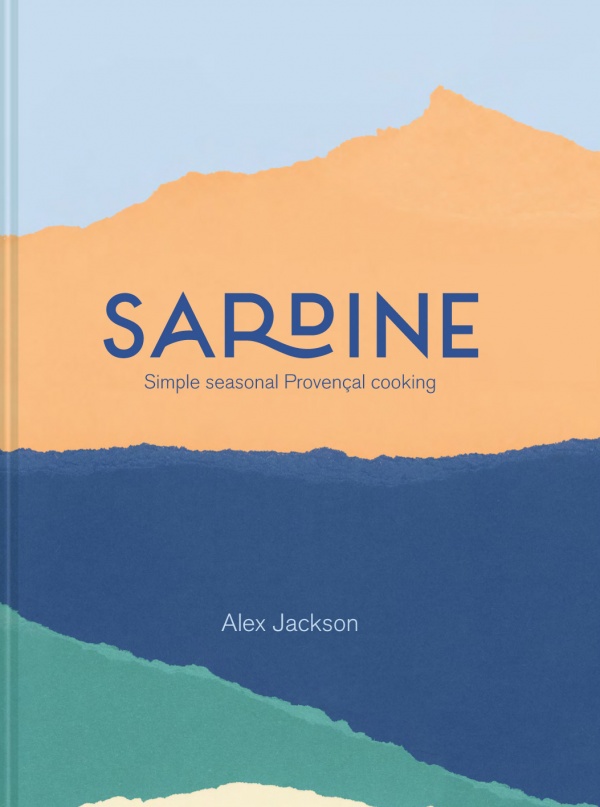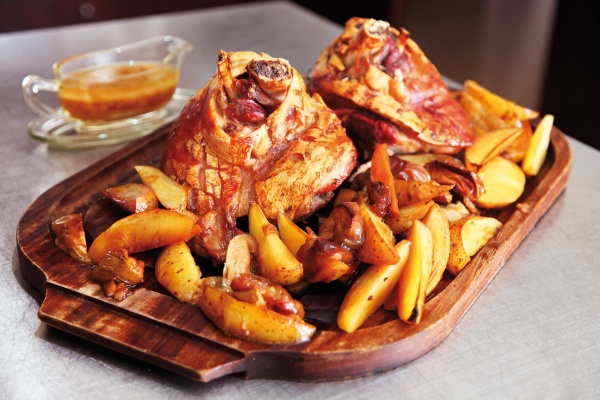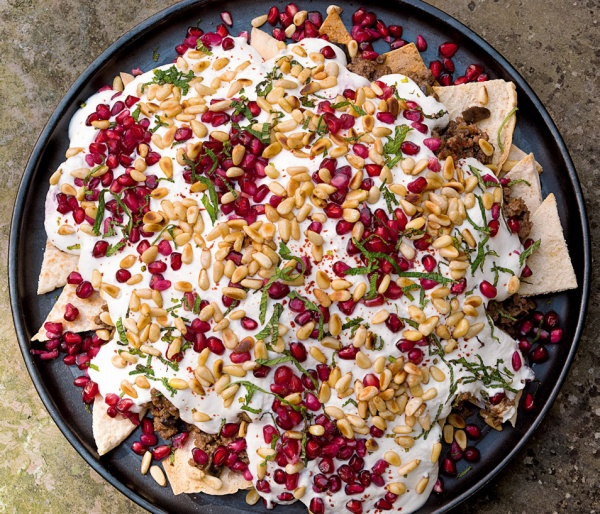Beef Shin, Chestnuts, Polenta and Gruyere
by Alex Jackson, featured in Sardine: Simple Seasonal Provencal Cooking Published by Pavilion BooksIntroduction
Much simpler than a daube, this red wine beef stew is based on the Tuscan peposo, which is usually pared down to the bare bones - beef, red wine, garlic, pepper and salt. Sometimes I tuck a bay leaf in too alongside the chestnuts that soften and soak up the broth. Wet polenta or mashed potato provide a bit of buttery ballast. Use a proper Gruyere, aged for eighteen months or more, or else something similar like Marechal, L'Etivaz or Beaufort. Beef shin is an ideal cut for a stew like this. It requires no browning, just lots of time; simmering gently into submission.
For US cup measures, use the toggle at the top of the ingredients list.
Much simpler than a daube, this red wine beef stew is based on the Tuscan peposo, which is usually pared down to the bare bones - beef, red wine, garlic, pepper and salt. Sometimes I tuck a bay leaf in too alongside the chestnuts that soften and soak up the broth. Wet polenta or mashed potato provide a bit of buttery ballast. Use a proper Gruyere, aged for eighteen months or more, or else something similar like Marechal, L'Etivaz or Beaufort. Beef shin is an ideal cut for a stew like this. It requires no browning, just lots of time; simmering gently into submission.
For US cup measures, use the toggle at the top of the ingredients list.

Share or save this
Ingredients
Serves: 4
For the beef
- 1 x approx 1½ kilograms shin of beef (butchers are often tempted to cut beef shin into thick slices of about 5cm/2 inches 'like osso bucco', but resist this and ask for a big piece that is a third of a whole shin)
- 1 tablespoon black peppercorns
- 1 bulb garlic
- 1 bay leaf
- 1 bottle of red wine
- 1 x 250 grams packet cooked chestnuts
- salt
For the polenta
- 1⅕ litres water
- 250 grams good-quality coarse polenta
- 100 grams unsalted butter
- Parmesan cheese
- salt
To serve
- 100 grams Gruyere cheese
- good-quality olive oil
For the beef
- 1 x 3¼ pounds beef shank (butchers are often tempted to cut beef shin into thick slices of about 5cm/2 inches 'like osso bucco', but resist this and ask for a big piece that is a third of a whole shin)
- 1 tablespoon black peppercorns
- 1 bulb garlic
- 1 bay leaf
- 1 bottle of red wine
- 1 x 9 ounces packet cooked chestnuts
- salt
For the polenta
- 5 cups water
- 9 ounces good-quality coarse polenta
- ½ cup unsalted butter
- Parmesan cheese
- salt
To serve
- 3½ ounces Gruyere cheese
- good-quality olive oil
Method
Beef Shin, Chestnuts, Polenta and Gruyere is a guest recipe by Alex Jackson so we are not able to answer questions regarding this recipe
- To make the beef stew, put the beef shin in a heavy-based pan with all the other ingredients except the chestnuts. Top up with cold water to cover if necessary. Bring the pan to the boil over a high heat, then turn down to a gentle simmer. Using a slotted spoon, skim any scum that gathers on the surface. Be careful when adding salt at this stage. The beef will cook for a long time and the broth will reduce and intensify the seasoning: aim for seasoned but not salty.
- Cook the beef shin for 3½-4 hours, or until falling off the bone. It's important the tendons in the shin become soft and gloopy; these are good eating but not when undercooked. When the beef is almost ready, add the chestnuts - keep them as whole as possible at this stage. Either keep the beef warm until ready to serve, or cool and chill in the refrigerator overnight, which will only improve it.
- Meanwhile, make the polenta. The polenta should take about an hour to cook so try to time it to be ready roughly at the same time as the beef. Bring the water to the boil in a pan with a lid, then whisk in the polenta in a steady stream. The polenta will soon bubble in a violent volcanic fashion: turn the heat down so that the polenta blip blips slowly. Put on a tight-fitting lid and leave the polenta on the lowest heat possible for around 1 hour. This method, courtesy of an Italian chef who worked with us, requires no stirring! If you rather like stirring, as meditative as it can be, ignore the lid and stir the polenta every 5-10 minutes or so. Top up the water if you feel it is getting a bit too thick. After around 45 minutes to an hour, taste the polenta. It should be thick and creamy, the coarse grains softer and no longer gritty: it is ready. Whisk in the butter, some salt and Parmesan to taste. Keep the polenta covered and warm.
- To serve, put some polenta on a plate. Scoop out a piece or two of the melting beef, as well as some of the marrow from the bone. Spoon on a few chestnuts and some of the thin, tasty broth. Drizzle with olive oil and coarsely grate the Gruyere over the top - no Microplanes here, please.
- To make the beef stew, put the beef shin in a heavy-based pan with all the other ingredients except the chestnuts. Top up with cold water to cover if necessary. Bring the pan to the boil over a high heat, then turn down to a gentle simmer. Using a slotted spoon, skim any scum that gathers on the surface. Be careful when adding salt at this stage. The beef will cook for a long time and the broth will reduce and intensify the seasoning: aim for seasoned but not salty.
- Cook the beef shin for 3½-4 hours, or until falling off the bone. It's important the tendons in the shin become soft and gloopy; these are good eating but not when undercooked. When the beef is almost ready, add the chestnuts - keep them as whole as possible at this stage. Either keep the beef warm until ready to serve, or cool and chill in the refrigerator overnight, which will only improve it.
- Meanwhile, make the polenta. The polenta should take about an hour to cook so try to time it to be ready roughly at the same time as the beef. Bring the water to the boil in a pan with a lid, then whisk in the polenta in a steady stream. The polenta will soon bubble in a violent volcanic fashion: turn the heat down so that the polenta blip blips slowly. Put on a tight-fitting lid and leave the polenta on the lowest heat possible for around 1 hour. This method, courtesy of an Italian chef who worked with us, requires no stirring! If you rather like stirring, as meditative as it can be, ignore the lid and stir the polenta every 5-10 minutes or so. Top up the water if you feel it is getting a bit too thick. After around 45 minutes to an hour, taste the polenta. It should be thick and creamy, the coarse grains softer and no longer gritty: it is ready. Whisk in the butter, some salt and Parmesan to taste. Keep the polenta covered and warm.
- To serve, put some polenta on a plate. Scoop out a piece or two of the melting beef, as well as some of the marrow from the bone. Spoon on a few chestnuts and some of the thin, tasty broth. Drizzle with olive oil and coarsely grate the Gruyere over the top - no Microplanes here, please.






Tell us what you think
Thank you {% member.data['first-name'] %}.
Explore more recipesYour comment has been submitted.